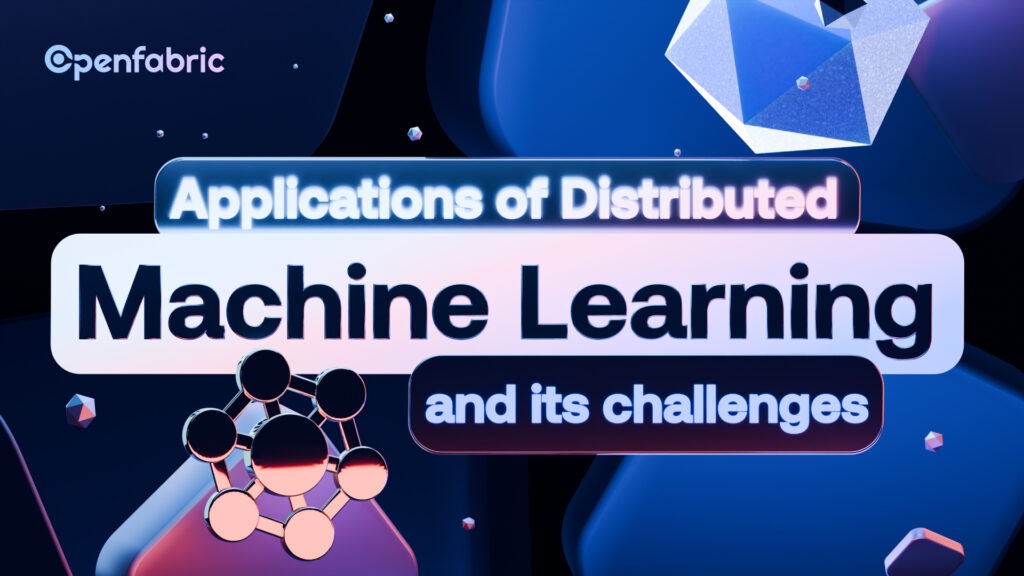
July 11, 2025 6 minutes read
Applications of distributed machine learning and its challenges

Machine learning is applied in many sectors. In marketing, distributed machine learning shares the burden from consumer data and helps companies to target better. Traditional routes are under threat from big data and real-time response. With DML, more machines can go to work in training sophisticated models with improved capabilities. By spreading load on added computing resources, DML can work on diverse data sets in record time. This is just one of the many applications of distributed machine learning.
In this article, we will address more of the applications of distributed machine learning and major challenges it faces during proper execution. Interestingly, we previously explored the concept of distributed machine learning. You can check it out in our blog page to learn more about this innovative concept.
Let’s get started!!
Applications of Distributed Machine Learning
In our previous blog, we discussed what distributed machine learning was. However, today, the party is differentDistributed Machine Learning is contributing massively to these regards:
Automatic Speech Recognition (ASR)
Big Tech companies like Google and Amazon depends on distributed machine learning to process tons of audio data to create complex models. These models carry on their backs some of the world’s most efficient virtual assistants including Google Assistant and Alexa.
To get familiar with diverse languages, ASR needs considerable speech data sets. DML eases the process by splitting the work across multiple GPUs to scale efficient training. Each node is given a subset to process and update to the model accordingly.
The update goes up the chain in two ways: synchronous or asynchronous stochastic gradient descent.
In synchronous, the worker nodes compute their local data and present it to a parameter server to aggregate before updating the model. On another hand, asynchronous takes up processed local data from each worker node to update model parameters. As you’d expect, each method has its advantages and tradeoffs.
DML assists Google Assistant to deal with bulk data from different languages, accents, and environments. Environment is important since not everyone is opportune to stand in a room free of interference. Sharing the workload cuts down model training time and keeps Google Assistant competitive among its peers.
Fraud detection
In finance systems, DML can quickly analyse transaction data to sieve out any fraudulent activities and preserve privacy and time. An advantage is continued improvement as the nodes process similar data.
Suspicious activities are time bound and if allowed to continue can lead to irreparable damage. A distributed network finds a point of failure in a timely fashion to save institutions their images and dollars. This highlights the need to keep financial data safe, and DML has security provisions. Through a federated learning approach, DML allows a network of servers to retain their raw data and work together collaboratively.
A central server takes on processed data from each node and aggregates them for model update. This update is sent back to the nodes to understand the current state. By allowing raw data separately, federated learning defends against data breaches. Random forest can pull outliers and abnormal activities from smaller datasets to the joy of the financing world.
Recommendation systems
Distributed Machine Learning presents again when you visit the for you page on social media, when your favorite store is pitching a Christmas cart, and also in the top picks for you section on Netflix. DML can study millions of users and items, matching preferences and making users feel special and seen.
The data volume remain on the rise. However, DML is primed to distribute clusters of user data including clicks, searches, purchases,viewing duration to nodes for timely analysis. With deep learning, users can get personalized recommendations, as the model takes note of slight nuances about them. As processing progress, the model shuns delay in data transfer so that options stay current. Thanks to DML’s parallel nature.
Energy rationing
Resources serve a greater purpose when we manage them effectively. DML is changing how facilities and grid operators process data in real time. Now, they can adapt to real time demands and cut out wastage.
DML can forecast the amount of electricity needed in an area against the capacity of available renewable energy sources. This ability helps to balance out supply and demand, leading to appropriate resource allocation. This model helps managers to anticipate attacks and equipment failure for timely intervention so that power supply continues without hitches.
In California, solar electricity generation has met a duck curve. The generation capacity against demand is optimal during the day, but as night time reaches, it starts tho decline. This later decline is due to less than optimal solar energy production when demand begins to peak. With DML, the state invests in strategic distributed resources to collect data and conserve energy. The wins from this intervention were; reduced communication overhead costs, positive customer impact, and rapid failure detection.
Challenges facing the applications of distributed machine learning
Despite how DML reshapes data use in managing delicate systems, it comes up short in these areas:
Data Sharing
Privacy and security are concerns for data sharing among nodes. Although, a defense against attack is to share model updates alone. However if a hacker breaks in and grabs this update, they can piece together parts of the training data. There must be robust security measures to help companies guard against data breaches.
Node rebalancing
Nodes can give way for a number of reasons. To prevent a node from getting overwhelmed and becoming a single point of failure, rebalancing continues to redistribute load for nodes to handle without breaking down. But rebalancing doesn’t guarantee node redundancy. Node failure brings the initial issue back, if it occurs.
Communication overhead
Data is split between nodes to distribute workload. Communication overhead refers to the time taken by these nodes to exchange information during the training process. If this time is too extensive, it can affect model performance. Factors contributing to communication overhead include network speed, communication patterns, and security measures.
Fault tolerance
It takes one or two faulty nodes for the entire system to fall apart. DML systems have to be more fault tolerant for smooth running of operations. Asides hardware failures, disruptions can arise from network issues and other unforseen circumstances. Typical approaches to smooth this issue over like checkpointing and replication struggle to fit in when systems encounter real-time setbacks. There’s need for better strategies that ensure data availability and keep performance levels up.
Scalability
Processing large data volumes can challenge machine learning systems. They store process, and analyze enormous data. Stakeholders must work towards creating high-power algorithms to match up. Also, deep learning models have peculiar requirements to run. Together with hardware constraints, distributed machine learning can suffer from long training time and costly energy consumption.
Conclusion.
Distributed machine learning eases the burden on nodes and allows work on large data sets in small bits. It is saving brands in Automated Speech Recognition, fraud detection, streaming services, online stores, and energy grids. DML ensures intensified efforts where needed to conserve resources and maximize efficiency.
However, some areas can improve to make DML an absolute superpower. More security for model updates, node rebalancing for optimum action, reduced communication overhead, and better fault tolerance are priority reforms.
For more insights, kindly visit our WEBSITE today!

